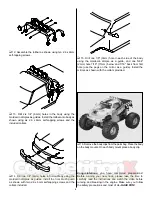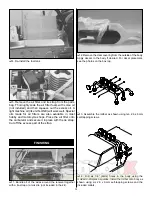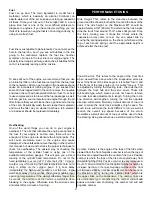
Fuel
Fuel can go bad. The main ingredient in model fuel is
methanol, which is basically an alcohol. Alcohols can
absorb water out of the air, so keep your fuel jug capped at
all times. Store your fuel out of the sunlight and in a cool
place. Bad fuel is one of the most difficult problems to
diagnose in engines. If you have tried everything you can
think of to remedy an engine that is not running correctly, try
using some fresh fuel.
Fuel line is susceptible to pinhole leaks. You cannot see the
hole in the fuel line, but if you see air bubbles in the line
going to the carburetor, replace the fuel line. Another
symptom of a leak in the fuel line is a surging engine. The
properly tuned engine will surge when the air bubbles hit the
carb. It is basically leaning out the mixture.
To keep dirt out of the engine, we recommend that you use
an inline fuel filter on the fuel line running from the fuel tank
to the carburetor. Dirt can get caught in the needle seat and
cause an inconsistent running engine. If you suspect that
some dirt has lodged itself in the carb, remove the needles
and clean the carb with denatured alcohol or fuel. It can help
to use compressed air to blow out the fuel passages as well.
Dirt can get into your carburetor and engine through the air
filter. Ensure that your air cleaner has a good seal to the top
of the carb. Periodically wash the air cleaner foam element
and re-oil the filter. Any air cleaner that has a torn element
or a bad seal should be replaced immediately.
Overheating
One of the worst things you can do to your engine is
overheat it. The oils that lubricate the engine are carried in
the fuel. If your engine is set too lean, there will not be
enough oil in the engine to lubricate the internal parts. This
will cause premature wear in the engine and cause
damage. We have talked about overheating in other parts of
this manual, but we want to stress the proper techniques to
check for overheating. The easiest way of checking the
temperature of the cylinder head is using one of the
available temperature gauges. This will give you a direct
reading of the cylinder head temperature. Do not let the
head temperature exceed 220° Fahrenheit (104° Celsius).
Another way of checking the head temperature is to put a
drop of water on the cylinder head. If it boils away
immediately, the high-speed needle is set too lean. If the
water boils away in 3-5 seconds, the engine is within proper
operating temperatures. If the water boils away longer than
5 seconds, the mixture is set rich which is preferable when
breaking in the engine. Otherwise lean the mixture some
and retest after a minute of running.
Ride Height:
This refers to the clearance between the
ground and the chassis, both at the front and the back of the
truck. The ride height on the Maximum MT should be
approximately 2-3/8" (60mm). To determine the ride height,
drop the truck from around 6"-12" above flat ground. Drop
the truck, making sure it drops flat. Check where the
suspension arms come to rest. You can adjust ride by
moving the spring adjusters on the shock (which are at the
top of each shock spring) until the appropriate height is
achieved after the drop test.
Toe-In/Toe-Out:
This refers to the angle of the front tires
when viewed from above when the suspension arms are
level. If the fronts of the tires angle in, it is called “toe-in” and
if the fronts of the tires angle out, it is called “toe-out.” This
is adjusted by turning the steering rods - the rods that run
between the front hub and the servo saver. These are
turnbuckle type, which means you do not have to remove
the rods to make adjustments in length. Turning the rod in
one direction will lengthen, turning the rod the opposite
direction will shorten. Normally a small amount of toe-in is
used to make the truck track straight at high speed. Too
much toe-in will make the truck difficult to turn as well as
reduce the overall top speed because of tire scrub.
Sometimes a small amount of toe-out will be used to help
the steering. As a general rule use a small amount of toe-in.
Camber:
Camber is the angle of the tops of the tires when
viewed from the front. Negative camber is when the tops of
the tires are angled towards the center of the truck. Positive
camber is where the tops of the tires are angled away from
the center of the truck. Positive camber is very rarely used,
if ever. A small amount of rear negative camber is helpful to
increase traction in the rear. Negative camber at the front
will increase stability. Camber adjustments can be made on
the Maximum MT by turning the “camber rods,” which are
the upper links on the suspension. The camber links are
also turnbuckle type. Lengthening the camber rod will add
positive camber and shortening the camber rod will add
negative camber.
PERFORMANCE TUNING
17



































